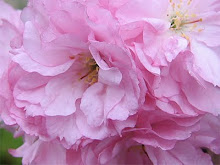
It's delicious! This morning that's what I had for my breakfast: California Organic Wild Rice (from Lundberg Family Farms) with a few tamari roasted almonds and a little ume plum vinegar and maple syrup sprinkled on top.
I had rinsed and soaked a half-cup of wild rice overnight in one and a half cups of water, which I then used to cook the rice in. I brought it to a boil in a quart-size pot, reduced the heat to a low flame, covered the pot, and then let it cook for about twenty to thirty minutes. (At one or two points, I had to lift the lid to release some steam and keep it from boiling over.)
Before, I've always had wild rice mixed with regular "true rice," that is, Asian rice, and this morning I decided to try it by itself. I'm glad I did!
Wild rice is different than black rice, by the way. Black rice (or "Forbidden Rice") is a "true rice" that's black in color and wild rice (also black in color, on the outside at least) is not a "true rice" although it is a cereal/grain from the grass family. Side by side, a wild rice grain is longer and narrower with sharp pointed ends (more yin) while a black rice grain is shorter and wider with rounded ends (more yang).
There are many reasons why I love wild rice:
• It's a grain that's native to this continent.
• It's grown and harvested locally in my state. (Therefore it's closer to me and my center.)
• It's very fragrant, fluffy, and reminds me of the winter holiday season.
• It's a good substitute for yang acid-forming animal foods, because it still is yang, but much closer to a balance between yin and yang.
• It's not as yang as regular short-grain brown rice and is good when I need to lighten up a little!
• It falls in the yang acid-forming category of the four basic macrobiotic food groups, which is needed for a well-balanced meal.
Here's what wikipedia says about wild rice, and black rice.
Related Blog Articles:
Whole Grains For Centering
What Is The Macrobiotic Centering Diet?
Ten Macrobiotic Diets By George Ohsawa
Four Basic Food Groups — Yin—Yang—Acid—Alkaline






















































